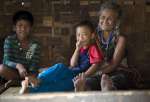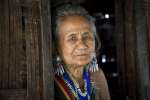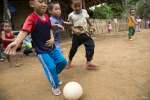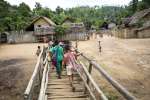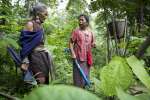UNHCR seeking access to returned Lao Hmong
News Stories, 29 December 2009

© REUTERS/Sukree Sukplang
Ethnic Hmong stand inside a truck at the Ban Huay Nam Khao camp in Thailand's Phetchabun province before being forcibly repatriated to Laos.
GENEVA, December 29 (UNHCR) – The United Nations refugee agency on Tuesday formally approached the government of Laos seeking access to Lao Hmong deported from Thailand a day earlier. Among those sent back were people recognized by UNHCR as being in need of international protection.
UNHCR also called on the government of Thailand to provide details of assurances provided to it by Laos, under a bilateral agreement between the two governments, concerning the treatment of the returned Hmong.
The refugee agency has asked to be informed of steps taken by Thailand to ensure that commitments made under this framework are effectively honoured.
Thailand has a long history as a country of asylum in the South-east Asian region. However, on Monday it deported some 4,000 Lao Hmong from two camps, one in the northern province of Petchabun and another in Nong Khai, which is located across the Mekong River from Laos in the country's north-east.
UNHCR was given no access to people in the first camp, while those in Nong Khai were all recognized refugees who had been in detention for almost three years. UNHCR has no formal presence in Laos.
The forced return on Monday of the Lao Hmong took place despite UNHCR's urging of the Thai government to halt its plans for their deportation. In a statement last Thursday, UN High Commissioner for Refugees Antonio Guterres warned that by doing so Thailand risked setting "a grave international example."
A fundamental principle in international customary law is that refugees and people awaiting asylum applications should not be returned to their countries of origin except on a strictly voluntary basis.
The key document on refugee protection in full, plus the text of the Protocol
UNHCR advocates fair and efficient procedures for asylum-seekers
Zero-Star "Hotel" that Asylum-Seekers Call Home in Dijon
France is one of the main destinations for asylum-seekers in Europe, with some 55,000 new asylum applications in 2012. As a result of the growing number of applicants, many French cities are facing an acute shortage of accommodation for asylum-seekers.
The government is trying to address the problem and, in February 2013, announced the creation of 4,000 additional places in state-run reception centres for asylum-seekers. But many asylum-seekers are still forced to sleep rough or to occupy empty buildings. One such building, dubbed the "Refugee Hotel" by its transient population, lies on the outskirts of the eastern city of Dijon. It illustrates the critical accommodation situation.
The former meat-packing plant is home to about 100 asylum-seekers, mostly from Chad, Mali and Somalia, but also from Georgia, Kosovo and other Eastern European countries. Most are single men, but there are also two families.
In this dank, rat-infested empty building, the pipes leak and the electricity supply is sporadic. There is only one lavatory, two taps with running water, no bathing facilities and no kitchen. The asylum-seekers sleep in the former cold-storage rooms. The authorities have tried to close the squat several times. These images, taken by British photographer Jason Tanner, show the desperate state of the building and depict the people who call it home.
Zero-Star "Hotel" that Asylum-Seekers Call Home in Dijon
Refugees from Myanmar: Ethnic Karens Seek Shelter
Over 2,000 refugees from Myanmar have crossed the border into Thailand in recent months. Most claim to be fleeing renewed conflict and human rights abuses in Kayin state, Myanmar. The mainly ethnic Karen refugees say their houses and villages have been burned and civilians killed. Many were weak upon arrival, suffering from illnesses such as malaria, after a long, dangerous journey to the camps through heavily mined areas. The refugees have been arriving at government-run camps, mainly in the Mae Hong Son area in northern Thailand.
UNHCR is working with the Thai government and non-governmental organisations to ensure the new arrivals are admitted to the camps and provided with adequate shelter and protection. Shelter has been a major issue as the capacity in many refugee camps has been overwhelmed. In a breakthrough in mid-May, Thai authorities agreed to build proper houses for the new arrivals.
There are currently 140,000 refugees from Myanmar living in nine border camps in Thailand, many of them have been there for up to 20 years.
Refugees from Myanmar: Ethnic Karens Seek Shelter
Angelina Jolie revisits Myanmar refugees on World Refugee Day
UNHCR's Special Envoy Angelina Jolie spent this year's World Refugee Day with Karenni refugees from Myanmar. Some have been in exile in Thailand for 30 years, making this one of the longest-running refugee situations in the world.
On her fourth visit to the refugee camps in Thailand, Jolie met Baw Meh's family, three generations of refugees who have lived in Ban Mai Nai Soi camp since 1996.
The family told Jolie they fled Myanmar's Kayah state thinking they would return home shortly. Eighteen years later, they are still here. Baw Meh, 75, lost her husband last year. He died before he could fulfill his dream of returning home. Some of their family members have been resettled to third countries. Others have chosen to stay. Baw Meh has refused to go, preferring to stay close to her village.
Like many refugees along the border, her family is watching the reform process in Myanmar closely and mulling the prospect of eventual return. "After 30 years in exile, the best solution we can give these refugees is the right and power to choose their own way forward," said Jolie. "This is our chance to get it right, to break the vicious cycle of conflict and displacement once and for all."
Angelina Jolie revisits Myanmar refugees on World Refugee Day


Greece: Ramping up refugee reception
UNHCR staff are working with Government authorities, NGOs and volunteers on the beaches of the Greek island of Lesvos to receive cold, wet and fearful asylum seekers making landfall around the clock. They wrap them in thermal blankets and take them to warm, safe emergency accommodation at transit sites, with power and Wi-Fi connectivity.


There are more refugees and displaced people now than at any time since the Second World War
To help them, to know who they are, to give them support now and in the future UNHCR must use the most modern tools available. UNHCR plans to capture refugees' biometrics in up to 10 countries this year, and in all its operations by 2018.


Thailand: Nader, a saxophonist from Syria - World Refugee Day 2015
"Music has helped me in everything - morally, financially, even my manners." Nader is a third-generation refugee.

































